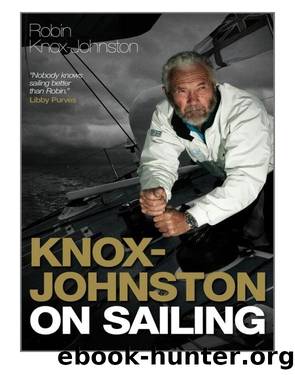Knox-Johnston On Sailing by Robin Knox-Johnston

Author:Robin Knox-Johnston
Language: eng
Format: epub
Publisher: John Wiley & Sons, Ltd.
Published: 2011-04-12T16:00:00+00:00
Why are some people so casual about tying knots? They either donât know the right knot to use or donât know how to tie it properly. Perhaps they feel that so long as the knot holds it does not matter which one it is, but a knot is rarely an end in itself. It is temporary and being able to untie it is as important as being able to tie it properly.
There are six basic knots everyone should know: reef knot, bowline, round turn and two half-hitches, the rolling hitch, clove hitch and sheet bend. I would add the carrick bend for reasons I will come to. Armed with these knots and knowing what each is for, a person becomes halfway to being useful about deck.
We use the term âknotâ to cover almost anything we do with a ropeâs end, but actually a knot is anything we do with an unravelled ropeâs end, like a splice. Tying two ropes together is a âbendâ and tying a rope to any object is a âhitchâ.
The bowline is probably one of the most useful and used knots. As Clipper crews know, I am liable to jump aboard and ask a crew to tie me a bowline. Failure to do so means I demonstrate again how it is done then sit with the crew until they have tied 10 correctly and consecutively. Fail on number nine and we start counting again at one. The repetition may be boring, but it is one way to help remember â tie a few each day for a while and youâll own the knot for life. So a little effort with the end of a sheet while waiting for a turn on the helm can bring dividends.
The main advantage of a bowline is that it is a breaking knot â it can be undone easily as the loop can be pushed over the standing part to loosen it. But crew need to be aware that it can come undone if it is not pulled tight before use, especially with slippery rope. A reef knot will break if the two ends are pushed towards each other.
If you are trying to tie two ropes of unequal size together a sheet bend is the right answer. If you lack confidence in your knot, the fallback is a bowline in the end of each rope. A clove hitch locks onto itself and is ideal for fenders and tying anything to a round bar or rope. It was used to secure ratlines on shrouds and the old sailors would not have used it unless they trusted it. A rolling hitch often comes in handy, but remember to put a couple of half hitches in before it if you are using it as the end of a stopper.
One of my favourites is the carrick bend. It is very easy to learn, like most good bends it looks right when made properly and it is also a breaking knot, with a loop at each end.
Download
This site does not store any files on its server. We only index and link to content provided by other sites. Please contact the content providers to delete copyright contents if any and email us, we'll remove relevant links or contents immediately.
Crossroads by Kaleb Dahlgren(468)
A Vineyard in Tuscany by Ferenc Máté(408)
Paul Cézanne by Jon Kear(403)
The Colossus of Maroussi () by Henry Miller(396)
Korean Air War by Michael Napier(390)
Taking Paris by Martin Dugard(372)
Queen Victoria by Lytton Strachey(364)
By-Line Ernest Hemingway by Ernest Hemingway(360)
An Arctic Man by Ernie Lyall(357)
Lost Among the Birds by Neil Hayward(349)
The Longest Winter by Alex Kershaw(344)
Sister of the Road: The Autobiography of Box-Car Bertha by(325)
On Fiji Islands by Ronald Wright(324)
Undaunted by John O. Brennan(320)
Travels with Lizbeth: Three Years on the Road and on the Streets by Lars Eighner(319)
Come Fly the World by Julia Cooke(314)
Journey to Portugal by Jose Saramago(305)
Diaries 1969â1979 The Python Years by Palin Michael(286)
Featherhood by Charlie Gilmour(282)
